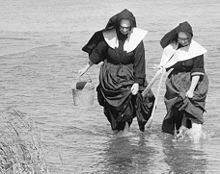Clam digging
Clam digging is a North American term for a common way to harvest clams (edible infaunal bivalve mollusks) from below the surface of the tidal sand flats or mud flats where they live.To harvest cultivated clam beds, aquaculturists often use a much smaller version (hand pulled) from the offshore dredge.The head of these rakes have long tines attached to a "basket-like" cage in which the clams are collected.In the Minas Basin area of Nova Scotia, digging for soft-shelled clams is usually done with a clam hack, a spading fork with its short handle bent perpendicularly away from the fork's head.Clam digging on the New England coast is done using a "clam hoe" (a pitchfork with the handle cut off about 18 in or 460 mm from the tines then bent about 70 degrees) and a "hod" or "roller" (a half bushel basket built using wood lathes or wire mesh) and hip waders (boot that extend up to the top of the legs).



Three quarter pantsCape Cod, MassachusettsLong IslandToni FrissellHanedainfaunalbivalvemollusksmud flatsrecreationallycommerciallycolloquiallyshovelquahogsurf clamsdredgingaquaculturistsMinas BasinNova Scotiasoft-shelled clamsspading forkbushelhip wadersrazor clamsOregonWashington stateClamdiggerWillem de KooningClamdigger (train)Northeast CorridorGathering seafood by handFishing tackleFish hookCircle hookHooksetSniggleFishing lineBraidedMonofilamentMultifilamentPower proSwivelFishing sinkerArlesey BombBombardaDownriggerSandsinkerFishing rodBamboo fly rodFishing reelFishing rod tapersFly rod buildingFishing baitBait fishBoiliesGroundbaitVermicompostWorm charmingPlastic baitDeadstickingPlastic wormFishing luresArtificial flyHeddonLittle CleoMormyshkaOriginal FloaterSabikiSpinnerbaitSpoon lureSpoonplugSurface lureSwimbaitTopwater lureZara SpookBite indicatorsFishing floatPellet wagglerShortfloatingQuiver tipFishing rigCarolina rigChod rigDrop shot rigHair rigTexas rigDiving maskHip bootPersonal flotation deviceWadersWetsuitFish stringerTackle boxFishing techniquesAma diversFlounder trampingNoodlingPearl huntingScallop aquacultureTrout binningTrout ticklingBowfishingGiggingHarpoonHawaiian slingPolespearSpearfishingSpeargunTridentFishing linesAnglingDroplineDrum linesHandline fishingJiggerpoleJiggingJug fishingLongline fishingSpin fishingTip-upTrollingTrotlineFishing netsCast netCheena valaDrift net